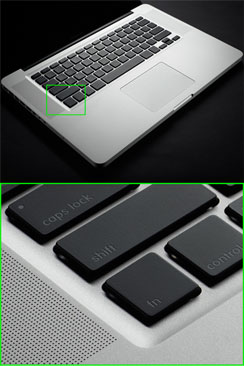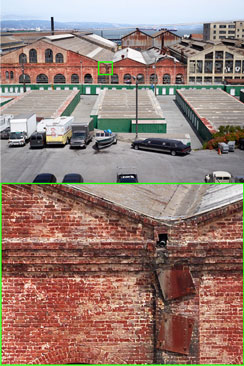The advice to forget about megapixels when camera shopping definitely doesn’t apply at the pro end of the spectrum. Photographer Peter Belanger has two amazing posts demonstrating his 60 megapixel Phase One p65+: It’s all about the megapixel and Can you count the bricks?



Daniel Gasienica
on 12 Aug 09…and here’s how you deliver those megapixels (or even gigapixels) on the web: http://gasi.ch/blog/inline-multiscale-image-replacement/
Powered by the open source OpenZoom framework: http://openzoom.org/
Cheers, Daniel
Tim
on 12 Aug 09FALSE
Megapixels don’t matter if you have a crappy lense / sensor.
This is why the Mars rover uses only a 1 megapixel camera but has an awesome lens and sensor.
NASA has a write up exactly about this and how mega-pixels does in fact matter far less than the lens / sensor.
http://www.space.com/businesstechnology/technology/pancam_techwed_040114.html
Just think about the amazing detailed photos obtained from the Mars rovers … then keep in mind that it was captured simply by a 1 mega-pixel camera … which is far less than most camera phones these days.
Do you serious think if you had, say a 60 mega-pixel camera phone, you’d be able to get awesome photos. I imagine not.
David Andersen
on 12 Aug 09Not exactly false Tim, since the size of the sensor (and type) matters. If you have a good one, the pixel count obviously matters.
Tim
on 12 Aug 09@David Andersen
Just to be sure I’m clear, I didn’t say size didn’t totally matter.
I said:
Which is then why I go on to make the example of having a 60 megapixel camera phone …. because I highly doubt camera phone have high quality lenses/sensors.
Greg H
on 12 Aug 09This is how Google created Google Maps Terrain
Though, Google used an inferior 50 megapixel camera (instead of 60 megapixel) to take the aerial photo.
I think that was so that each state had it’s own dedicated 1 megapixel.
Greg H
on 12 Aug 09By the way, you should try zooming in and out…. it’s kind of freaky :)
David Andersen
on 12 Aug 09@Tim
Yeah, I gotcha Tim; read your whole comment. However, your bold FALSE is hyperbolic and the original post did say “at the pro end of the spectrum”. No one was talking about a camera phone.
Tor Løvskogen Bollingmo
on 12 Aug 09Pro end? Getting a 60 mpx camera makes you a pro? This is more like the tech end. The pro end of photography would care more about the motive than the resolution.
How is this pro end photography, Ryan?
Magic Toolbox
on 12 Aug 09For highly detailed products, mega high-res images are a powerful tool to aid sales. This Canon camera for example:
http://www.magictoolbox.com/magictouch/
Stijn Goris
on 12 Aug 09Ken Rockwell has an interesting article on megapixels
Justin Bell
on 12 Aug 09If you’re looking at a new medium format digital camera, they’re all going to have quite a high MP count. So I say the advice holds true even at the pro end. But yeah, the detail you get with a setup like that is pretty amazing. For those of us with smaller budgets, photostitching can sometimes produce excellent results.
Adam
on 12 Aug 09There are many bottlenecks to image resolution. The number of megapixels a sensor has is just one of them. Of course a Phase One digital back is going to perform well, particularly if it’s behind a Carl Zeiss lens built for a medium format camera.
There’s little reason to spend a fortune on a Phase One unless you’re planning to blow your image up to poster or billboard size. For everything else, 35mm (and digital equivalents) work just fine – and in that world, a good lens is particularly important.
JamesK
on 12 Aug 09Given the simpler is better mantra in these parts, I’m surprised getting closer to the building or laptop isn’t praised as a better solution for “seeing the bricks”!
PavelT
on 12 Aug 09http://www.dpreview.com/reviews/specs/Canon/ shows interesting info: how many mega pixels per square centimeter. This where the difference between camera phone and Canon is.
Tim
on 12 Aug 09@PavelIT
Wow, now I understand why the Canon EOS 5D is so expensive.
The pixel desity (1.5 MP/cm²) is crazy, crazy low.
Micheal
Oliver Ruehl
on 13 Aug 09Oh please… not this discussion again! Oh please… I can’t resist to join the discussion ;-)
It is really impressive how far the digital sensors are today. That fact is not going to “artistically” improve the photos that float around, but the engineers are really doing a great job. Now we just need faster technology to transfer these huge files to our computers.
@Tor I’m totally with you. The gear is not as important as a good eye for composition and shape. But many industries demand images like the ones above. Those are images for a special purpose and need to sell.
I also don’t agree that this gear makes you “pro”. To become a good photographer, leave this site soon and go out and shoot some more ;-)
For inspiration: Search “Henri Cartier Bresson”. What he did with a small Leica is beyond anything that can be put on a 60MP chip today. A genius.
I’m going back now to count the bricks ;-)
Love you 32signals, Oliver
Justin Bell
on 15 Aug 09Oliver: Many of his images are of people. As someone interested in landscapes, I can tell you that equipment can make or break the image, depending on exactly what you are trying to capture. If you like a landscape because of all the rich textures and detail, then having all that disappear would be like using a lens that made people’s facial expressions disappear. Of course the idea that the gear makes you a good photographer is silly, but so is this counter-idea that technology can’t improve the artistry of photography.
Oliver Ruehl
on 18 Aug 09@Justin Yes, you are right. That is why landscape photographers still use old large format cameras.
I think we can summarize that a photographer should use the gear that is appropriate for the task at hand.
This discussion is closed.